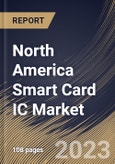Smart card technology is subject to international norms and guidelines. Several such specifications and standards are used only in certain industries. For example, the Secure Technology Alliance's ISO/IEC 7816 and ISO/IEC 14443 international standards are supported by the International Organization for Standardization in the United States, where smart card technology complies with them. In recent years, the demand for various types of smart cards like contactless, contact, etc., has increased significantly. Contactless smart cards don't need to touch the reader directly. As a result, ticketing and payments are growing in popularity.
Mass transit and tolls on the highway are two common uses. Using inexpensive NXP Mifare Ultralight chips and paper/card/PET rather than PVC has increased the use of "Contactless" smart cards in transportation. This has lower media costs, enabling the usage of inexpensive tickets and day passes for transit. A PVC or plastic smart card with a bigger memory is typically minutely expensive. Due to their tamper-resistant design, smart cards have been promoted as appropriate for personal identification duties. Typically, a cryptographic algorithm is implemented by the semiconductor. The internal state of the algorithm can be partially recovered using several techniques.
Due to the expansion and development of the banking and financial industries, the industry is also anticipated to experience significant growth. Governments and financial institutions now favor contactless smart cards over all others. Data from Visa indicated that by April 2021, a sizable share of active debit and credit cards in the US were contactless-enabled. Identity can be verified using smart cards by utilizing public key infrastructure (PKI). Examples include various cards used by other governments for their residents as well as the Common Access Card (CAC) issued by the US Department of Defense (DoD). Therefore, the smart card IC market will expand rapidly in the region throughout the forecast period.
The US market dominated the North America Smart Card IC Market by Country in 2022, and would continue to be a dominant market till 2029; thereby, achieving a market value of $909.6 million by 2029. The Canada market is poised to grow at a CAGR of 8% during (2023-2029). Additionally, The Mexico market should witness a CAGR of 7.1% during (2023-2029).
Based on Type, the market is segmented into Microprocessor and Memory. Based on Interface, the market is segmented into Contactless, Contact and Dual. Based on Application, the market is segmented into USIMs/eSIMs, ID cards, Financial Cards, and IoT Devices. Based on Industry, the market is segmented into Telecommunications, BFSI, Government & Healthcare, Transportation, Education, Retail and Others. Based on countries, the market is segmented into U.S., Mexico, Canada, and Rest of North America.
The market research report covers the analysis of key stake holders of the market. Key companies profiled in the report include Toshiba Corporation, ON Semiconductor Corporation, Microchip Technology Incorporated, STMicroelectronics N.V., Texas Instruments, Inc., Sony Corporation, Analog Devices, Inc., Infineon Technologies AG, Samsung Electronics Co., Ltd. (Samsung Group) and NXP Semiconductors N.V.
Scope of the Study
By Type
- Microprocessor
- Memory
By Interface
- Contactless
- Contact
- Dual
By Application
- USIMs/eSIMs
- ID cards
- Financial Cards
- IoT Devices
By Industry
- Telecommunications
- BFSI
- Government & Healthcare
- Transportation
- Education
- Retail
- Others
By Country
- US
- Canada
- Mexico
- Rest of North America
Key Market Players
List of Companies Profiled in the Report:
- Toshiba Corporation
- ON Semiconductor Corporation
- Microchip Technology Incorporated
- STMicroelectronics N.V.
- Texas Instruments, Inc.
- Sony Corporation
- Analog Devices, Inc.
- Infineon Technologies AG
- Samsung Electronics Co., Ltd. (Samsung Group)
- NXP Semiconductors N.V.
Unique Offerings
- Exhaustive coverage
- The highest number of Market tables and figures
- Subscription-based model available
- Guaranteed best price
- Assured post sales research support with 10% customization free
Table of Contents
Companies Mentioned
- Toshiba Corporation
- ON Semiconductor Corporation
- Microchip Technology Incorporated
- STMicroelectronics N.V.
- Texas Instruments, Inc.
- Sony Corporation
- Analog Devices, Inc.
- Infineon Technologies AG
- Samsung Electronics Co., Ltd. (Samsung Group)
- NXP Semiconductors N.V.








